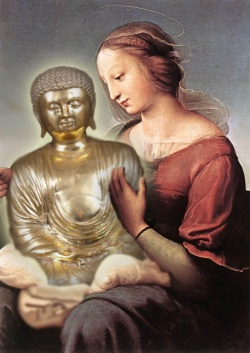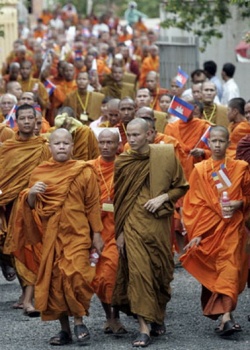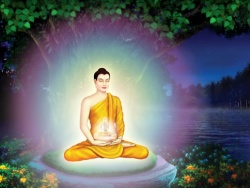Theosophical Society
The Theosophical Society is an organization formed in 1875 to advance theosophy. The original organization, after splits and realignments, currently has several successors.
The Theosophical Society was officially formed in New York City, United States, in November 1875 by Helena Blavatsky, Henry Steel Olcott, William Quan Judge and others. Its initial objective was the "study and elucidation of Occultism, the Cabala etc." After a few years Olcott and Blavatsky moved to India and established the International Headquarters at Adyar, in Madras (Chennai). They were also interested in studying Eastern religions, and these were included in the Society's agenda. After several iterations the Society's objectives evolved to be:
1. To form a nucleus of the universal brotherhood of humanity without distinction of race, creed, sex, caste, or colour.
2. To encourage the study of comparative religion, philosophy, and science.
3. To investigate the unexplained laws of nature and the powers latent in man.
The Society was organized as a non-sectarian entity. The following was stated in the Constitution and Rules of the Theosophical Society
ARTICLE I: Constitution
4. The Theosophical Society is absolutely unsectarian, and no assent to any formula of belief, faith or creed shall be required as a qualification of membership; but every applicant and member must lie in sympathy with the effort to create the nucleus of an Universal Brotherhood of Humanity
...
ARTICLE XIII Offences
1. Any Fellow who shall in any way attempt to involve the Society in political disputes shall be immediately expelled.
2. No Fellow, Officer, or Council of the Theosophical Society, or of any Section or Branch thereof, shall promulgate or maintain any doctrin[e ]as being that advanced, or advocated by the Society.
The Society reformulated this view in a resolution passed by the General Council of the Theosophical Society on December 23, 1924.
The Hidden Masters
The Society's seal incorporated the Swastika, Star of David, Ankh, Aum and Ouroboros symbols
Seal of the Theosophical Society - Door decoration at Kazinczy Street 55, Budapest (Hungary).
One of the central philosophical tenets promoted by the Society was the complex doctrine of The Intelligent Evolution of All Existence, occurring on a Cosmic scale, incorporating both the physical and non-physical aspects of the known and unknown Universe, and affecting all of its constituent parts regardless of apparent size or importance. The theory was originally promulgated in the Secret Doctrine, the 1888 magnum opus of Helena Blavatsky. According to this view, Humanity's evolution on Earth (and beyond) is part of the overall Cosmic evolution. It is overseen by a hidden Spiritual Hierarchy, the so-called Masters of the Ancient Wisdom, whose upper echelons consist of advanced spiritual beings.
Blavatsky portrayed the Theosophical Society as being part of one of many attempts throughout the millennia by this hidden Hierarchy to guide humanity – in concert with the overall Intelligent Cosmic Evolutionary scheme – towards its ultimate, immutable evolutionary objective: the attainment of perfection and the conscious, willing participation in the evolutionary process. These attempts require an earthly infrastructure (such as the Theosophical Society) which she held was ultimately under the inspiration of a number of Mahatmas, members of the Hierarchy.
Schisms
Theosophical Society, Adyar, India, 1890
After Helena Blavatsky's death in 1891, the Society's leaders seemed at first to work together peacefully. This did not last long. Judge was accused by Olcott and then prominent Theosophist Annie Besant of forging letters from the Mahatmas; he ended his association with Olcott and Besant in 1895 and took most of the Society's American Section with him. The original organisation led by Olcott and Besant remains today based in India and is known as the Theosophical Society - Adyar. The group led by Judge further splintered into a faction led by Katherine Tingley, and another associated with Judge's secretary [Ernest Temple Hargrove]]. While Hargrove's faction no longer survives, the faction led by Tingley is today known as the Theosophical Society with the clarifying statement, "International Headquarters, Pasadena, California". A third organization, the United Lodge of Theosophists or ULT, in 1909 split off from the latter organization.
In 1902, Rudolf Steiner became General Secretary of the German/Austrian division of the Theosophical Society. He maintained a Western-oriented course, relatively independent from the Adyar headquarters. After serious philosophical conflicts with Annie Besant and other members of the International leadership on the spiritual significance of Christ and on the status of the young boy Jiddu Krishnamurti (see section below), most of the German and Austrian members split off in 1913 and formed the Anthroposophical Society. The latter remains active today and has branches in several countries, including the US and Canada.
The "World Teacher"
In addition to the stated objectives, as early as 1889 Blavatsky publicly declared that the purpose of establishing the Society was to prepare humanity for the reception of a World Teacher: according to the Theosophical doctrine described above, a manifested aspect of an advanced spiritual entity (the Maitreya) that periodically appears on Earth in order to direct the evolution of humankind. The mission of these reputedly regularly appearing emissaries is to practically translate, in a way and language understood by contemporary humanity, the knowledge required to propel it to a higher evolutionary stage.
If the present attempt, in the form of our Society, succeeds better than its predecessors have done, then it will be in existence as an organized, living and healthy body when the time comes for the effort of the XXth century. The general condition of men's minds and hearts will have been improved and purified by the spread of its teachings, and, as I have said, their prejudices and dogmatic illusions will have been, to some extent at least, removed. Not only so, but besides a large and accessible literature ready to men's hands, the next impulse will find a numerous and united body of people ready to welcome the new torch-bearer of Truth. He will find the minds of men prepared for his message, a language ready for him in which to clothe the new truths he brings, an organization awaiting his arrival, which will remove the merely mechanical, material obstacles and difficulties from his path. Think how much one, to whom such an opportunity is given, could accomplish. Measure it by comparison with what the Theosophical Society actually has achieved in the last fourteen years, without any of these advantages and surrounded by hosts of hindrances which would not hamper the new leader.
This was repeated by then prominent Theosophist Annie Besant in 1896, five years after Blavatsky's death. Besant, who became President of the Society in 1907, thought the appearance of the World Teacher would happen sooner than the time-frame in Blavatsky's writings, who had indicated that it would not take place until the last quarter of the 20th century.
Jiddu Krishnamurti
One of the people who expected the imminent reappearance of the Maitreya as World Teacher was Charles Webster Leadbeater, then an influential Theosophist and occultist. In 1909 he "discovered" Jiddu Krishnamurti, an adolescent Indian boy, who he proclaimed as the most suitable candidate for the "vehicle" of the World Teacher. Krishnamurti's family had relocated next to the Theosophical Society headquarters in Adyar, India, a few months earlier.[13] Following his "discovery", Krishnamurti was taken under the wing of the Society, and was extensively groomed in preparation for his expected mission.
However, by 1925 Krishnamurti had begun to move away from the course expected of him by the leaders of the Theosophical Society in Adyar and by many Theosophists. In 1929 he publicly dissolved the Order of the Star, a worldwide organization created by the leadership of the Theosophical Society to prepare the world for the Coming of the Maitreya, and abandoned his assumed role as the "vehicle" for the World Teacher. He eventually left the Theosophical Society altogether, yet remained on friendly terms with individual members of the Society. He spent the rest of his life traveling the world as an independent speaker, becoming widely known as an original thinker on spiritual, philosophical, and psychological subjects.
Controversy and racial beliefs
Blavatsky had posited that humanity evolved through a series of stages called Root Races, the present, the Aryan, being the Fifth Root Race (of seven). The Root Races do not refer to ethnicities. They represent evolutionary stages the whole humanity is engaged in, each new Root Race being more advanced than the previous one. She taught that the earlier stage of evolution took place in Atlantis during the Fourth Root-Race. The [[Aryan] Root Race]] was then only one more step in the evolutionary progression, to be eventually superseded by a more spiritual Root Race, the Sixth.
Regarding the concept of race as defined – in a comparatively more limited manner – by anthropology, sociology, and other disciplines, Blavatsky did not encourage superiority by any person or group, promoting the idea of the common origin and destiny of all humanity, and establishing the principle of universal brotherhood as the First Object of the Theosophical Society. She also proclaimed religious tolerance and inclusiveness stating, "Theosophists, collectively, respect the Bible as much as they do the sacred scriptures of other people, finding in it the same eternal truths as in the Vedas, the Zend-Avesta, the Tripitakas, etc." Conversely, Austrian/German ultra-nationalist Guido von List and his followers such as Lanz von Liebenfels, later selectively mixed parts of Blavatsky's occult philosophy with nationalistic and fascist ideas; this system of thought became known as Ariosophy . Some researchers, tracing the links between Ariosophy and Theosophy, stated that the latter relies mostly on "intellectual expositions of racial evolution". However in The Key to Theosophy, Blavatsky had stated that "The Society is a philanthropic and scientific body for the propagation of the idea of brotherhood on practical instead of theoretical lines.




